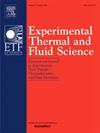横驻波频率和振幅对部分预混火焰振荡和模态转变影响的实验研究
IF 3.3
2区 工程技术
Q2 ENGINEERING, MECHANICAL
Experimental Thermal and Fluid Science
Pub Date : 2025-03-12
DOI:10.1016/j.expthermflusci.2025.111477
引用次数: 0
摘要
合理匹配声场与燃烧场,可以有效提高燃烧器功率密度。本文研究了在不同频率和振幅的周期性声激励下火焰的振荡模式和模式转换机理。用307.15 nm滤光片和ICCD相机捕捉OH*化学发光图像,使反应区可视化。利用快速傅里叶变换(FFT)和固有正交分解(POD)方法分析了OH*的强度波动和火焰的模态跃迁。结果表明,横向驻波对火焰的扰动与声场的强度和持续时间有关。用位移振荡因子(p*/St2)来描述声场对火焰锋面的影响。当p*/St2较低时,声场在火焰边缘引起小幅度的横向对称振荡。随着p*/St2的增大,火焰头部出现垂直振荡,火焰振荡频率与激励频率相匹配。在振荡中心附近观察到高强度的OH*化学发光区。当p*/St2过大时,声激励产生宏观流动,使火焰进入横向振荡,引起局部井喷,周期性中断,OH*强度降低。火焰放热强度在火焰模式由垂直振荡向横向振荡转变时达到峰值,以OH*亮度表示。本文章由计算机程序翻译,如有差异,请以英文原文为准。
Experimental study on the effects of transverse standing wave frequency and amplitude on oscillation and mode transition of partially premixed flame
Reasonable matching of the acoustic and the combustion field can effectively boost burner power density. This study investigates the oscillation modes of the flame and the mechanism of mode transition under periodic acoustic excitation at different frequencies and amplitudes. Visualize the reaction zone by capturing OH* chemiluminescence images with a 307.15 nm filter and an ICCD camera. The intensity fluctuation of OH* and modal transitions of flame are analyzed using Fast Fourier Transform (FFT) and Proper Orthogonal Decomposition (POD) methods. The results show that flame disturbances from transverse standing waves depend on both the strength and duration of the acoustic field. A displacement oscillation factor (p*/St2) is used to describe how the acoustic field affects the flame front. When p*/St2 is low, the acoustic field causes small-amplitude transverse symmetrical oscillations at the flame’s edges. As p*/St2 increases, vertical oscillations appear at the flame head, and the oscillation frequency of the flame matches the excitation frequency. High-intensity OH* chemiluminescence region is observed near the oscillation center. When p*/St2 is excessive, the acoustic excitation creates macro flow that causes the flame into transverse oscillation, causing local blowout, periodic disruption, and a decrease in OH* intensity. The flame heat release intensity, indicated by OH* brightness, peaks near the condition of flame mode transitions from vertical to transverse oscillation.
求助全文
通过发布文献求助,成功后即可免费获取论文全文。
去求助
来源期刊

Experimental Thermal and Fluid Science
工程技术-工程:机械
CiteScore
6.70
自引率
3.10%
发文量
159
审稿时长
34 days
期刊介绍:
Experimental Thermal and Fluid Science provides a forum for research emphasizing experimental work that enhances fundamental understanding of heat transfer, thermodynamics, and fluid mechanics. In addition to the principal areas of research, the journal covers research results in related fields, including combined heat and mass transfer, flows with phase transition, micro- and nano-scale systems, multiphase flow, combustion, radiative transfer, porous media, cryogenics, turbulence, and novel experimental techniques.
 求助内容:
求助内容: 应助结果提醒方式:
应助结果提醒方式:


